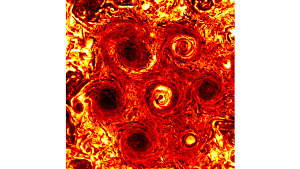Monday Bites: Swirls & Twirls
Monday Bites: Swirls & Twirls
 |
| Credit: NASA/JPL-Caltech Public Domain |
This isn't one of Van Gogh's canvases. But it's close to one. Jupiter's south pole, coming to view for the first time in four hundred years since Galileo Galilei had pointed his crude contraption of lens and lead towards the great planet, presents a wild landscape of monstrous cyclones with wind speeds going over 360 km/h (224 mph).
 |
| Credit: NASA/JPL-Caltech |
Over subsequent flybys, Juno watched that the system remained stable, and on its 23rd pass, on November 04, 2019, the previously five-member council had gained a new comrade. A smaller cyclone, about the size of Texas, had developed.
Going over the north pole, one finds a similar picture, but with eight peripheral cyclones swirling around in a regular octagon around a central vortex.
Jupiter presents a restless landscape. On Earth, a cyclone usually weakens as it crosses into land. Jupiter has no continental landmasses. Once a storm develops near the equator, it migrates to the poles, a characteristic feature of planets rotating about their axis. As multiple cyclones migrate toward the pole, it's natural to believe they eventually converge. Saturn has one giant hexagonal cyclone at each pole. However, for Jupiter, the individual vortices, instead of merging into one tempest, arrange themselves in striking perennial patterns. Why is it the way it is remains an open question, though.


Comments
Post a Comment